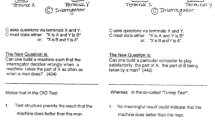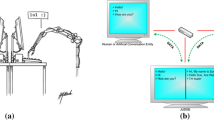Abstract
In the 1950s, Alan Turing proposed his influential test for machine intelligence, which involved a teletyped dialogue between a human player, a machine, and an interrogator. Two readings of Turing's rules for the test have been given. According to the standard reading of Turing's words, the goal of the interrogator was to discover which was the human being and which was the machine, while the goal of the machine was to be indistinguishable from a human being. According to the literal reading, the goal of the machine was to simulate a man imitating a woman, while the interrogator – unaware of the real purpose of the test – was attempting to determine which of the two contestants was the woman and which was the man. The present work offers a study of Turing's rules for the test in the context of his advocated purpose and his other texts. The conclusion is that there are several independent and mutually reinforcing lines of evidence that support the standard reading, while fitting the literal reading in Turing's work faces severe interpretative difficulties. So, the controversy over Turing's rules should be settled in favor of the standard reading.
Similar content being viewed by others
References
Cowley, S.J. and MacDorman, K.F. (1995), 'Simulating Conversations: The Communion Game', AI and Society 9, pp. 116-139.
Genova, J. (1994), 'Turing's Sexual Guessing Game', Social Epistemology 8, pp. 313-326.
Haugeland, J. (1985), Artificial Intelligence: The Very Idea. Cambridge, MA: MIT Press.
Hayes, P. and Ford, K. (1995), 'Turing Test Considered Harmful', Proceedings of the Fourteenth International Joint Conference on Artificial Intelligence, Montreal, Quebec, Canada, pp. 972-977.
Hodges, A. (1983), Alan Turing: The Enigma. New York: Simon and Schuster.
Ince, D.C., ed. (1992), Collected Works of A.M. Turing: Mechanical Intelligence. Amsterdam: North Holland.
Newman, M.H.A. (1955), 'Alan Mathison Turing', in Biographical Memoirs of Fellows of the Royal Society. London: Royal Soc., pp. 253-362.
Piccinini, G. (2001), 'Turing and the Mathematical Objection', Forthcoming in Minds and Machines.
Saygin A.P., Cicekli I. and Akman V. (2000), 'Turing Test: 50 Years Later', Minds and Machines 10, pp. 463-518.
Sterrett, S. (2000), 'Turing's Two Tests for Intelligence', Minds and Machines 10, pp. 541-559.
Traiger, S. (2000), 'Making the Right Identification in the Turing Test', Minds and Machines 10, pp. 561-572.
Turing, A.M. (1945), 'Proposal for Development in the Mathematical Division of an Automatic Computing Engine (ACE)', reprinted in Ince (1992), pp. 1-86.
Turing, A.M. (1947), 'Lecture to the London Mathematical Society on 20 February 1947', reprinted in Ince (1992), pp. 87-105.
Turing, A.M. (1948), 'Intelligent Machinery', reprinted in Ince (1992), pp. 107-127.
Turing, A.M. (1950), 'Computing Machinery and Intelligence', Mind 59, pp. 433-460.
Turing, A.M. (1951), 'Can digital computers think?' Typescript of talk broadcast on BBC Third Programme, 15 May 1951, AMT B.5, Contemporary Scientific Archives Centre, King's College Library, Cambridge.
Turing, A.M. (1952), 'Can automatic calculating machines be said to think?' Typescript of broadcast discussion on BBC Third Programme, 14 and 23 January 1952, between M.H.A. Newman, A.M. Turing, Sir Geoffrey Jefferson, R.B. Braithwaite, AMT B.6, Contemporary Scientific Archives Centre, King's College Library, Cambridge.
Turing, E.S. (1959), Alan M. Turing. Cambridge: Heifer & Sons.
Webb, J.C. (1980), Mechanism, Mentalism, and Metamathematics. Dordrecht: D. Reidel.
Rights and permissions
About this article
Cite this article
Piccinini, G. Turing's Rules for the Imitation Game. Minds and Machines 10, 573–582 (2000). https://doi.org/10.1023/A:1011246220923
Issue Date:
DOI: https://doi.org/10.1023/A:1011246220923




